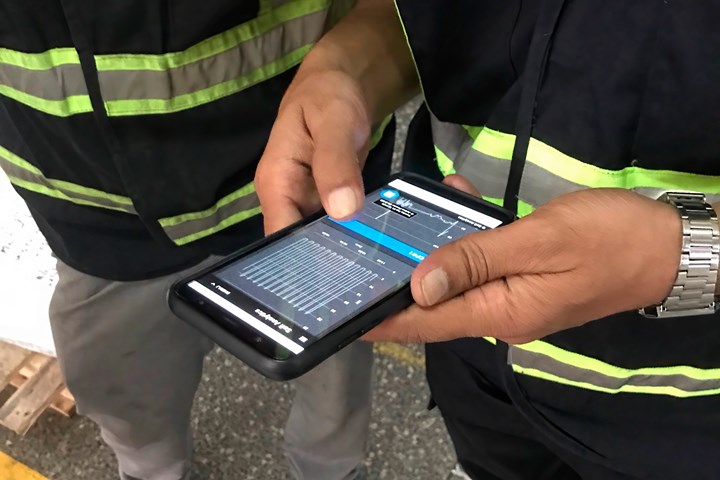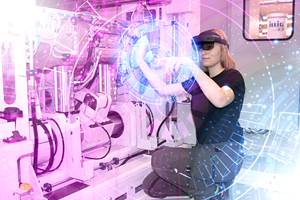Machine Monitoring Becomes Simpler And More Affordable Than Ever
A new application of an established technology makes production monitoring accessible to any manufacturer, with any type of equipment, and in almost no setup time.

In the Guidewheel system, simple current transformers (amperage sensors) clip around power cords to sense the “heartbeat” of the machine. They can be used to detect uptime, downtime, cycle time and more.
The big story of the “industrial internet of things” (IIoT or Industry 4.0) is more than just the ability to acquire, analyze and communicate data from production systems—it’s also about the rapid “democratization” of such technology, making it available to manufacturers of all sizes, and not just the largest firms with big budgets, big engineering teams, and ample timelines for training and installation.
“Our biggest impact is in reducing unplanned downtime and speeding changeovers and setups.”
One new player in that democratization effort is a three-year-old San Francisco company called Guidewheel (guidewheel.com). The firm’s website says it “is on a mission to empower all the world’s factories to reach sustainable peak performance. Our plug-and-play FactoryOps platform makes the power of the cloud accessible to any factory … to unlock big wins right away.”
“Any factory” means not only of any size, but with any type of machines, new or old, continuous or cyclical. Guidewheel already serves plastics and packaging customers, among a wide variety of industries. According to CEO Lauren Dunford, one blow molder tried out Guidewheel’s technology in a couple of plants, and after a couple of months extended it to 17 more.
And “right away” can mean in as little as one shift. What about those “big wins”?
Dunford answers that with all the enthusiasm of a tech startup leader: “In an environment of increasing pressure and uncertainty, every manufacturer needs to get more out of the equipment they have. Now, any factory can connect all of their machines to immediately identify and take actions to improve.” She adds, “We seek to get manufacturers out of a firefighting mindset and into a proactive mode. Our biggest impact is in reducing unplanned downtime and speeding changeovers and setups.”
Based on Proven Technology
What makes all this possible is a new application of a simple technology—the current transformer, essentially an amperage meter. As Dunford explains, maintenance engineers have used these small, inexpensive devices for decades to detect, for example, when a machine starts drawing excess power, possibly indicating a need for maintenance or even an impending malfunction.
Guidewheel uses the same information to detect when a machine is running or stopped, how long it has been running or not, and the number and period of cyclical operations. In the case of continuous operations such as extrusion, the level of current draw can be correlated with production rate.
Remote support and training enable users to get the system up and running in a matter of minutes.
FactoryOps, as Guidewheel puts it, is “inspired by the simple, universal truth that every machine on the factory floor has a power cord. Guidewheel clips onto any machine to turn its real-time ‘heartbeat’ into a connected, actively learning system that empowers teams to reduce lost production time, increase throughput and perform better and better over time.”
With Guidewheel’s Quick Start package, customers can get started with a 1:1 video call, after which Guidewheel sends a box of sensors and a communications hub. Customers can install the sensors themselves in just a few minutes by simply clipping them around the power cord on their machines. The sensors plug into a hub, which collects the sensor data and contains a router that sends the data to the cloud via WiFi, Ethernet or LTE (4G mobile) access. Each hub can connect to 15 machines within a 30-meter radius.

Over the course of one shift, the Guidewheel system “learns” the current conditions corresponding to a machine running under load, dry running, and paused. Shown here: current tracking of an extruder.
Remote support and training enable users to get the system up and running. The FactoryOps software tracks the current fluctuations in connected machines for typically one shift, to “learn” baseline values for running under load, dry cycling or dry running, and stopped. Users gain access (via phone, tablet or computer) to a password-protected site with a customized dashboard of operating data. Initially, the dashboard can provide availability statistics—run time for each machine, and configurable idle time and offline threshholds. With manual entry of production data, Guidewheel calculates performance statistics based on actual production vs. potential production based on preset machine productivity targets and run time. In addition, manual entry of data on good production or scrap enables Guidewheel to calculate quality metrics. With all these availability, performance and quality statistics, Guidewheel can automatically calculate OEE (overall equipment effectiveness).
What’s more, Guidewheel can automatically send alerts via text or email if any machine violates preset limits for production speed or idle time. This enables managers and production personnel to attend to problems as soon as they occur, rather than losing valuable production time while a machine sits idle and ignored.

Guidewheel users have internet access to a customized dashboard and receive automatic alerts when the system detects anomalies such as machine stoppage or changes in running speed or cycle time.
Who Can Benefit?
Dunford describes Guidewheel as aimed at mid-sized manufacturers, but in fact, it could benefit shops of almost any size. As previously mentioned, a blow molder with 19 plants has installed Guidewheel in every plant. Dunford says her firm also has customers monitoring just one or two large, high-output machines. She says, “If you have just a few machines and can easily keep an eye on all of them, perhaps you don’t need our system. But whatever the number of your machines, if you are feeling the pain of lost potential revenue, then we can help.” She notes that Guidewheel can monitor not just primary production machinery, but also auxiliary or downstream equipment—anything whose slowdown or stoppage would threaten plant profitability if it went unnoticed.
Here are some real-world examples of customers that have benefited from using Guidewheel to provide run-time tracking, alerts and real-time visibility into machine activity:
• A plant with 30 extruders and thermoformers reduced production costs by 20%.
• A plastic tank manufacturer uses Guidewheel on 15 extruders, grinders and rotomolding machines. The firm achieved 37% to 62% reductions in idle time on key machines and increased facility run time by 18% overall. OEE improved by 41% in six months.
• A packaging manufacturer uses Guidewheel on its most important machines, now expanding to nine locations. It identified and eliminated 1-3 hr/day of avoidable downtime on each machine.
• Another packaging manufacturer uses Guidewheel on key machines, thereby reducing changeover times between production runs by 50% from 6.8 hr/day to 3.4 hr/day. In addition, alerts enable technicians to respond immediately to problems, and the production manager can better plan capacity across machines for faster response to customers.
Related Content
Novel ‘Clamtainer’ Extends Thermoformer's Reach in Packaging
Uniquely secure latching expands applications for Jamestown Plastics’ patented clamshell package design.
Read MoreClock's Ticking: Register Now for 2023 SPE Thermoforming Conference
Three-day event kicks off Oct. 24 in Cleveland.
Read MoreEnhanced Digitization in Thermoforming
Illig’s Easy product family includes the newly developed Human Machine Interface, Illig Easy Touch.
Read MoreThermoformer Maximizes Productivity with 3D Printing
Productive Plastics has created an extensive collection of 3D printed manufacturing aids that sharply reduce lead times.
Read MoreRead Next
Troubleshooting Screw and Barrel Wear in Extrusion
Extruder screws and barrels will wear over time. If you are seeing a reduction in specific rate and higher discharge temperatures, wear is the likely culprit.
Read MoreLead the Conversation, Change the Conversation
Coverage of single-use plastics can be both misleading and demoralizing. Here are 10 tips for changing the perception of the plastics industry at your company and in your community.
Read MoreUnderstanding Melting in Single-Screw Extruders
You can better visualize the melting process by “flipping” the observation point so that the barrel appears to be turning clockwise around a stationary screw.
Read More







.png;maxWidth=300;quality=90)






















